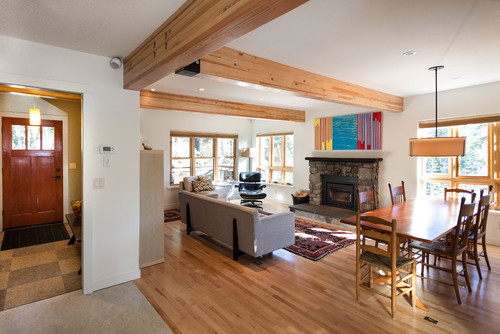A beam is an architectural element but sometimes a building structural element. Structural beams are completely different from beams that are used only for decorative purposes.

Photo by Kat Alves Photography – More living room photos
Beams used for structural purposes carry important loads where beam failure means in fact, the failure of the whole structure. Therefore, it is extremely important that the size and design of a structural beam to be check by a licensed professional, usually by a construction engineer.
There are also several major differences between structural and decorative laminated beams:
– The type of glue and fasteners that are used to make them;
– There are differences between outdoor and indoor beams; outdoor beams need a special kind of glue (waterlogged glue) and fasteners that are resistant to the weather vicissitudes;
– The quality and type of the boards that are laminated, their dimension and the orientation of the grain determine the strength of the laminated beam.
However, a laminated structural beam seems to have some important advantages over a solid wood beam. In fact, laminated wood beams are a better option than a single piece of wood beam.
They are less expensive and have a more predictable and reliable load-bearing potential, because you can orient the board layers in a way that neutralize any flaws and weaknesses in the wood, not to mention they can be built with several aesthetic features (curves and ornaments) and alternating wood shades and tones.
MATERIALS & TOOLS
– Oak boards ( long = 6-feet; wide = 12-inches; thick = 1-inch)
– Wood glue
– Table Saw; Paint Roller; Clamps;
– Plastic Sheet
STEPS
1| Before preparing the oak boards for gluing, make sure the wood is dried. However, any hump or crown caused by drying should be oriented toward the load of the beam (crown upwards).
2| Using the table aw rip your oak boards. You need 6-inches wide boards.
3| Lay a plastic sheet on the floor.
4| Using the paint roller apply a thin glue layer to the side of the 6-inches oak board. Make sure the glue is evenly applied on the board surface.
5| Take another board and turn it in a way that its grain orientation to be an opposite direction. Clamp this board to the glued board. Use a clamp every five or six inches and leave them on the plastic sheet, for at least an hour.
6| After one hour remove your clamps and apply a layer of glue to the both sides of the already two-board beam.
7| Place a new board on the each glued side with the grain orientation in the opposite direction. Clamp the boards again and leave them for another hour.
8| Remove your clamps and repeat the same procedure. Allow at least 24 hours the beam to cure before removing the clamps.
During beam lamination and cure, you may use fasteners instead clamps to compress the glue. But you need to be careful because fasteners can cause concentrated loads on your beam that can affect the beam integrity. However, the best idea is to consult a licensed professional or engineer.
Furniture Wood Types | How To Build A House (howtobuildahouseblog.com)


